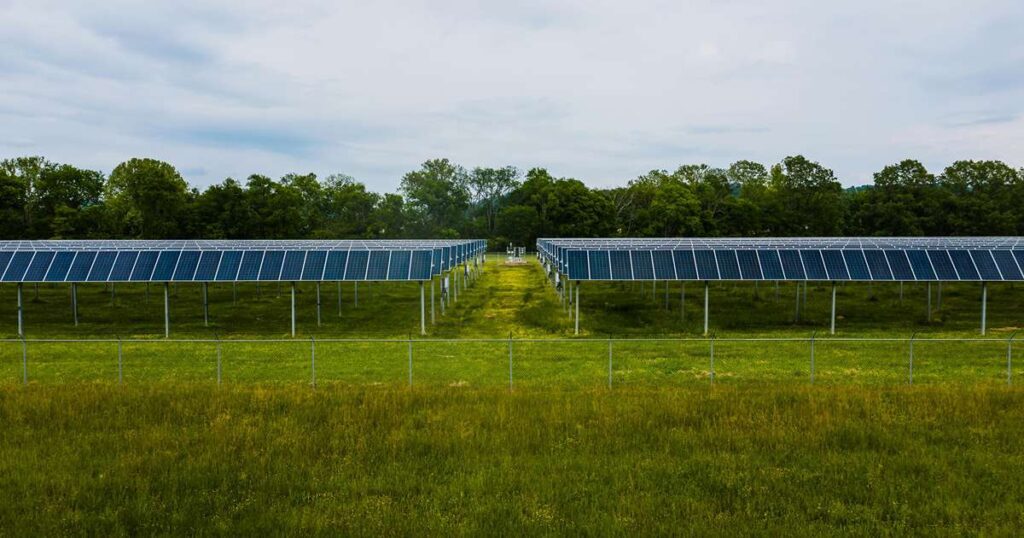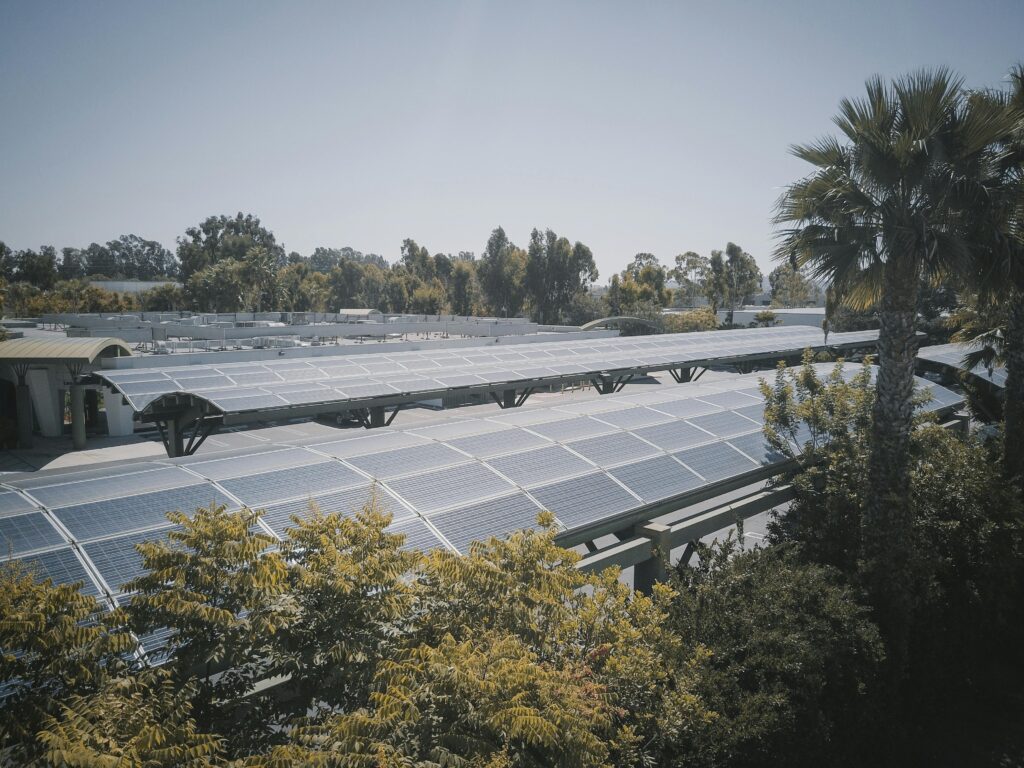Solar energy is becoming more and more popular as people look for cleaner and greener ways to power their homes and devices. One of the newest and most exciting developments in this field is the creation of Transparent solar panels.
These innovative panels are changing the way we think about solar power, making it possible to generate energy from surfaces like windows and screens that we never thought possible before.

Transparent solar panels offer a unique opportunity to harness solar energy without compromising the aesthetics of buildings and devices. They provide a way to integrate solar technology into everyday objects, allowing us to make better use of available sunlight without altering the appearance of our surroundings.
This article will delve into what transparent solar panels are, how they work, their benefits, applications, and the challenges they face.
Table of Contents
What Are Transparent Solar Panels?
These Solar Panels are a new and innovative type of solar technology that can generate electricity while still allowing light to pass through. Unlike traditional solar panels, which are dark and opaque, transparent solar panels can be see-through, similar to glass. This unique feature means they can be integrated into surfaces like windows, doors, and even electronic screens without obstructing the view or altering the design.

These panels are made from special materials that capture sunlight and convert it into electricity. The key difference from regular solar panels is that transparent solar panels only absorb certain wavelengths of light, primarily ultraviolet (UV) and infrared (IR) light, which are invisible to the human eye. The visible light, which we see, passes through, making the panels appear transparent.
There are two main types of transparent solar panels:
Partially Transparent Solar Panels:
These panels are partially transparent, meaning they have a degree of transparency but still show some tint or color. They balance transparency and energy generation and are often used in building windows and facades.
Fully Transparent Solar Panels:
These panels aim to be completely transparent, like regular glass. They are still in the research and development stage but hold great promise for future applications where aesthetics and visibility are crucial.
These Solar Panels can be used in various applications, from building windows to smartphone screens, offering a versatile and aesthetically pleasing way to generate clean energy.
How Do Transparent Solar Panels Work?
These Solar Panels work by capturing sunlight and converting it into electricity, just like traditional solar panels. However, they use special materials and technology that allow them to be see-through. Let’s navigate through the process step by step and in detail:
Special Materials:
- These Solar Panels are made from unique materials designed to capture sunlight without blocking visible light. Unlike traditional solar panels, which typically use silicon, transparent panels use materials such as organic photovoltaics (OPVs), dye-sensitized solar cells (DSSCs), or perovskite solar cells.
- These materials have the special ability to absorb ultraviolet (UV) and infrared (IR) light, which are parts of the light spectrum invisible to the human eye. By targeting these specific wavelengths, the panels can generate electricity while letting visible light pass through, maintaining their transparency.
Light Absorption:
- When sunlight hits the transparent solar panel, the special materials inside get to work by absorbing UV and IR light. This absorption process is critical because it allows the panels to generate electricity without blocking the visible light we rely on for sight.
- The absorbed UV and IR light excites electrons within the material, giving them energy. This process is similar to how traditional solar panels work but is tailored to only certain parts of the light spectrum.
Energy Conversion:
- Once the UV and IR light is absorbed and the electrons are excited, these electrons begin to move through the material. This movement creates an electric current, which is the flow of electricity.
- This electric current is then captured and directed for use. Just like traditional solar panels, the electricity generated by transparent panels can be used to power devices, charge batteries, or feed into the electrical grid.
Transmission of Visible Light:
- The transparent materials used in these panels are designed to let visible light pass through them. This means that even though the panel is hard at work generating electricity, it still looks like clear glass.
- This feature is particularly important for applications where maintaining natural light and visibility is crucial, such as in building windows, car sunroofs, and smartphone screens.
Types of Transparent Solar Panels:
Partially Transparent Panels:
- These panels have a slight tint or coloration because they only partially transmit visible light. They balance transparency and energy generation. You’ll often find these in building windows, providing both energy and a clear view. They might have a slight gray or green tint but still allow plenty of light through.
Fully Transparent Panels:
- These panels aim to be completely clear, like regular glass. They are more challenging to produce but offer the advantage of complete transparency. These are ideal for applications where aesthetics are crucial, such as smartphone screens and display windows. They look just like ordinary glass but have the added benefit of generating electricity.
Transparent solar panels represent a significant advancement in solar technology, offering a more versatile and aesthetically pleasing way to harness solar energy. By using everyday surfaces like windows and screens to generate clean energy, we can enjoy the benefits of solar power without compromising on design or functionality.
Benefits of Transparent Solar Panels
These Solar Panels offer several advantages over traditional solar panels. Let’s explore these benefits in detail:

Aesthetic Appeal:
- One of the most significant advantages of These Solar Panels is their aesthetic appeal. Unlike traditional solar panels, which can be bulky and visually intrusive, transparent panels blend seamlessly with their surroundings. They look like ordinary glass, making them ideal for use in buildings, car windows, and electronic devices without altering their appearance.
- Architects and designers can integrate these panels into structures without compromising the design, allowing for creative and innovative building solutions.
Versatility in Usage:
- These Solar Panels can be used in various applications where traditional panels would not be suitable. For instance, they can be installed in the windows of buildings, allowing natural light to enter while generating electricity at the same time.
- They can also be used in car sunroofs, smartphone screens, greenhouse roofs, and even on wearable technology. This versatility opens up new possibilities for generating solar power in places where it was previously impractical.
Energy Efficiency:
- While traditional solar panels are known for their high efficiency, These Solar Panels also offer significant energy benefits. They can convert UV and IR light, which are not typically utilized by traditional panels, into electricity. This ability to harness additional parts of the light spectrum can contribute to overall energy production.
- Although currently less efficient than traditional panels in terms of overall energy conversion, their unique ability to generate power without blocking visible light makes them a valuable addition to solar technology.
Integration with Existing Infrastructure:
- These Solar Panels can be easily integrated into existing infrastructure, such as windows and glass facades, without the need for significant modifications. This means that buildings can be retrofitted with transparent panels to enhance their energy efficiency.
- This integration can lead to significant energy savings, especially in urban areas where space for traditional solar panels is limited.
Reduction in Carbon Footprint:
- By generating electricity from sunlight,These Solar Panels help reduce reliance on fossil fuels, thereby lowering carbon emissions. This contributes to a cleaner environment and helps combat climate change.
- Buildings equipped with These Solar Panels can become more energy-independent and environmentally friendly, aligning with green building initiatives and sustainability goals.
Enhanced Building Performance:
- These Solar Panels can also enhance the performance of buildings in other ways. For example, they can provide shading and reduce the need for air conditioning by blocking some UV and IR radiation. This can lead to lower energy consumption for cooling.
- They can also provide additional insulation, helping to maintain indoor temperatures and reduce heating costs in colder climates.
These Solar Panels offer a combination of aesthetic, practical, and environmental benefits, making them a promising technology for the future of sustainable energy. By integrating these panels into various surfaces, we can generate clean energy in ways that were not possible before.
Challenges and Future of Transparent Solar Panels
Challenges and Future of Transparent Solar Panels
While These Solar Panels offer many benefits, there are also challenges to their widespread adoption. Here are some key challenges and a look at the future of this technology:

Efficiency:
- Currently, These Solar Panels are less efficient than traditional opaque panels. This means they generate less electricity per unit area. Researchers are working on improving the efficiency of these panels to make them more competitive with traditional options.
Cost:
- These Solar Panels are more expensive to produce than traditional solar panels. The materials and manufacturing processes required to create transparent panels are more complex and costly.
- Reducing these costs through technological advancements and economies of scale will be crucial for broader adoption.
Durability:
- The durability and longevity of These Solar Panelsneed to be improved. They must withstand various environmental conditions, such as extreme temperatures and weather, without degrading.
- Ensuring long-term performance is essential for their viability in different applications.
Regulatory and Market Acceptance:
- Regulatory hurdles and market acceptance are also challenges. Building codes and regulations need to adapt to accommodate the use of transparent solar panels in construction.
- Educating consumers and stakeholders about the benefits and potential of transparent solar panels is important for their acceptance and adoption.
Future Prospects:
- Despite these challenges, the future of transparent solar panels looks promising. Advances in materials science and nanotechnology are likely to improve the efficiency and reduce the cost of these panels.
- As the demand for renewable energy sources continues to grow, transparent solar panels will play an increasingly important role in creating sustainable and energy-efficient buildings and devices.
- Continued research and development, along with supportive policies and incentives, will drive the growth and adoption of this innovative technology.
Conclusion
Transparent solar panels are a groundbreaking technology that offers a new way to harness solar energy without compromising aesthetics or functionality. They can be integrated into various surfaces, from building windows to smartphone screens, providing a versatile and attractive solution for generating clean energy.
While there are challenges to overcome, the potential benefits of transparent solar panels are significant. They represent a step forward in the quest for sustainable and renewable energy solutions, helping to reduce our reliance on fossil fuels and mitigate the impacts of climate change.
As research and development continue to improve their efficiency and reduce costs, transparent solar panels are poised to become a common feature in our built environment, powering our homes, vehicles, and devices in a clean and unobtrusive way.
Transparent solar panels not only promise to revolutionize the solar industry but also offer a glimpse into a future where our everyday objects can contribute to a greener planet. By embracing this technology, we can move towards a more sustainable and energy-efficient world.
FAQ’s:
1. What materials are used in transparent solar panels?
Transparent solar panels utilize advanced materials like organic photovoltaics (OPVs), dye-sensitized solar cells (DSSCs), and perovskite solar cells. These materials are designed to absorb ultraviolet (UV) and infrared (IR) light while allowing visible light to pass through.
2. How do transparent solar panels compare to traditional solar panels in terms of efficiency?
Transparent solar panels generally have lower efficiency compared to traditional solar panels. This is because they capture only UV and IR light, which constitutes a smaller portion of the sunlight spectrum. Ongoing research aims to enhance their efficiency, but they are currently less effective in generating electricity.
3. Are transparent solar panels more expensive than traditional solar panels?
Yes, transparent solar panels are typically more costly than traditional solar panels. The production involves more advanced and expensive materials and manufacturing processes. However, as technology advances and production scales up, prices are expected to decrease.
4. Can transparent solar panels be used in extreme weather conditions?
The durability of transparent solar panels can vary depending on their construction and materials. While they are designed to be robust, ongoing research is focused on ensuring they can withstand extreme weather conditions like heavy rain, snow, and high temperatures.
5. How do transparent solar panels integrate with existing building structures?
Transparent solar panels can be incorporated into existing building structures by replacing or enhancing conventional glass surfaces. They are suitable for use in windows, facades, and skylights, providing energy generation without disrupting the building’s design.
6. What is the lifespan of transparent solar panels?
The lifespan of transparent solar panels can vary based on the materials and environmental conditions. Currently, their lifespan is still being studied, but they are expected to last a similar duration as traditional solar panels, typically 25-30 years, with proper maintenance.
7. Are there any specific maintenance requirements for transparent solar panels?
Maintenance for transparent solar panels is similar to traditional panels. Regular cleaning to remove dirt and debris is necessary to maintain performance. Additionally, periodic inspections are recommended to identify any potential damage or degradation.
8. Can transparent solar panels be used in residential homes?
Yes, transparent solar panels are suitable for residential applications, particularly in windows and skylights. They allow homeowners to generate solar energy while preserving natural light and views, contributing to energy efficiency in the home.
9. How do transparent solar panels contribute to energy savings?
Transparent solar panels help reduce energy costs by generating electricity from sunlight, which can be used to power devices, charge batteries, or lessen reliance on the grid. In buildings, they also provide additional insulation and reduce heating and cooling expenses.
10. What are the future prospects for transparent solar panels?
The future of transparent solar panels looks bright, with ongoing research focused on improving efficiency, reducing costs, and enhancing durability. As technology advances, transparent solar panels are expected to become more widely used in various applications, including buildings, vehicles, and electronic devices, contributing to sustainable energy solutions.